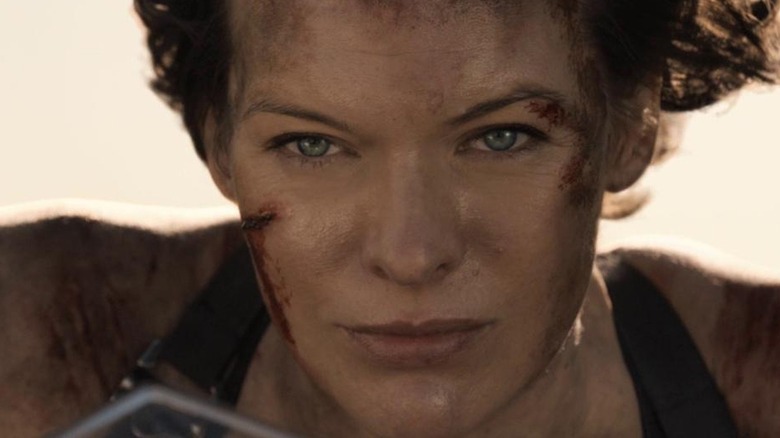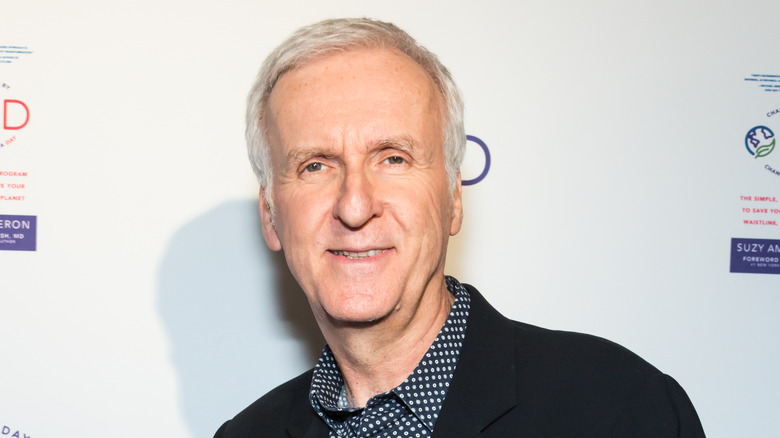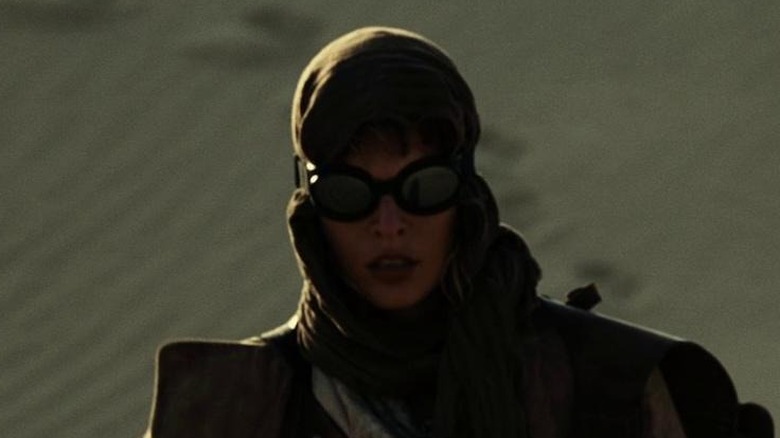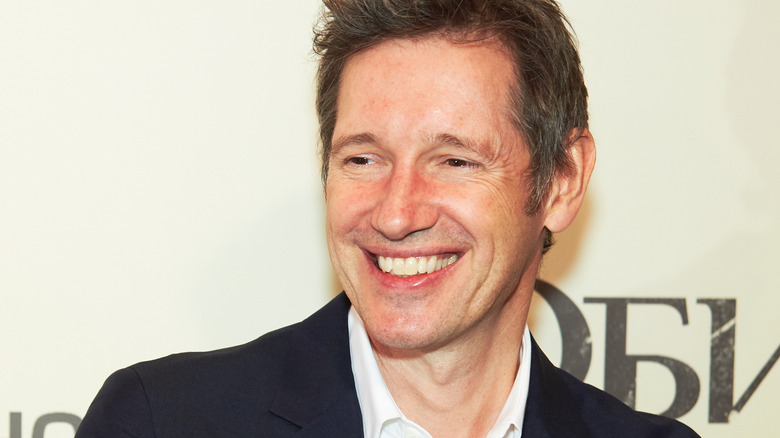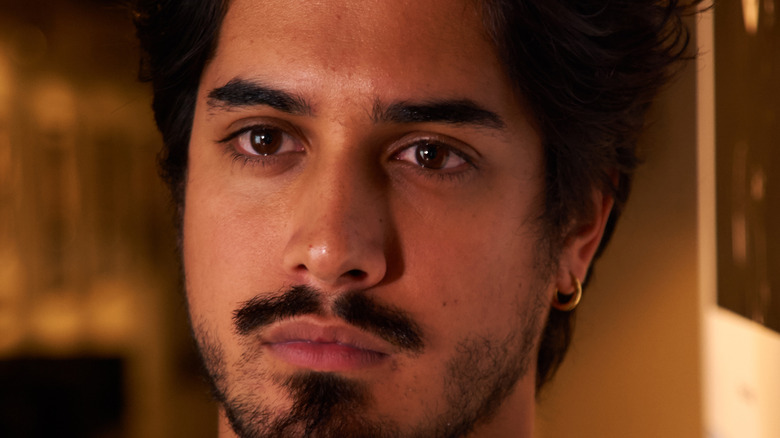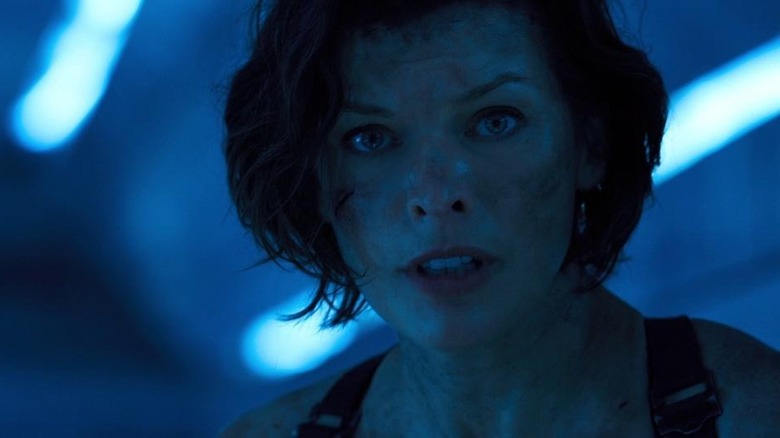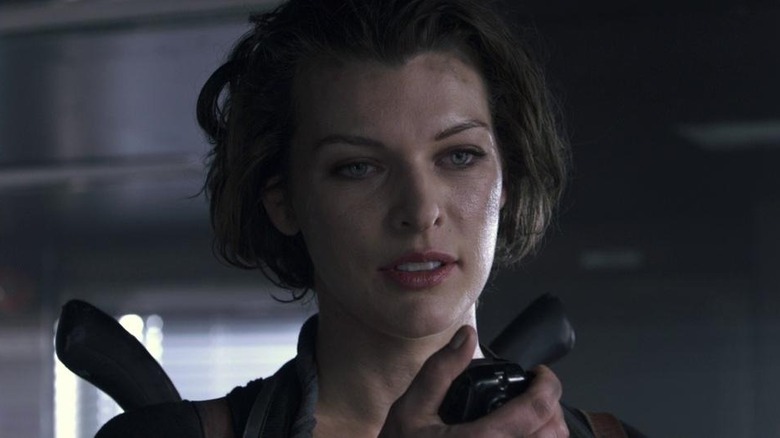The Untold Truth Of The Resident Evil Movies
Video game movies are not known for being successes. Lots of films in this subgenre have gone on to both lose money and fail to spawn the franchises they were supposed to launch. A significant exception to this trend, though, is the "Resident Evil" movies. Based on the 1990s Capcom video game series (which is still producing new installments), the first entry in this franchise arrived in theaters in 2002 and proceeded to kick off a seemingly endless deluge of sequels. Even the conclusively titled "Resident Evil: The Final Chapter" wasn't the end of "Resident Evil" in the world of cinema. A reboot in the form of "Resident Evil: Welcome to Raccoon City" arrived nearly five years after "The Final Chapter," thus ensuring the continued presence of this rare ongoing video game movie series.
Considering all the installments the "Resident Evil" franchise has produced, it shouldn't be surprising that a lengthy untold truth lies behind these projects. This look into the franchise covers everything from how George A. Romero was once supposed to direct the original "Resident Evil" installment to what iconic filmmaker loves the initial "Resident Evil" film. Most video game movies never produce much more than one widely-derided installment, but the history of the "Resident Evil" films reflects the shockingly dense pop culture presence these films have assembled.
George A. Romero was approached to direct Resident Evil
When you think of zombies in video games, "Resident Evil" is one of the first properties that leaps to mind. In film, however, the unquestioned emperor of zombies is George A. Romero, whose 1967 work "Night of the Living Dead" forever changed how these creatures were depicted on camera. Given his enduring influence on zombies in cinema, it's no surprise that when the very first "Resident Evil" movie was getting off the ground, Romero got an offer to helm the feature.
In a rundown on this abandoned version of the "Resident Evil" movie by Variety, the outlet noted Romero's connection to this franchise was solidified when he directed a commercial for the video game "Resident Evil 2." This advertisement proved impressive enough for Romero to get signed on to helm the feature-length movie adaptation of "Resident Evil." Despite Romero not being a video game person, his version of "Resident Evil" was incredibly faithful to the source material. However, despite having such an iconic auteur at their disposal, producers Sony and Capcom dismissed Romero due to their dislike for his screenplay. Later, Paul W.S. Anderson would be hired to direct while Romero returned to the zombie movie in the 2000s with projects like "Land of the Dead."
Why the original Resident Evil didn't directly adapt the games
A recurring complaint among devotees of the original "Resident Evil" games is how the movies have rarely embraced the source material. They've largely told their own story, one that does involve zombies and the Umbrella Corporation but is otherwise a standalone property. This has been a conscious choice from the get-go, as evidenced by comments from "Resident Evil" director Paul W.S. Anderson explaining his creative direction for this inaugural movie.
Talking to Shivers Magazine (via Spong), Anderson explained that a critical reason for embracing new mythology for "Resident Evil" was his belief that horror films rely on unpredictability to be scary. For him, adhering to the storylines and characters of the video games would've made the proceedings too familiar to be frightening. He also noted that the film would have to employ elements only familiar to die-hard fans of the games. However, Anderson's desire to make a movie that could primarily appeal to the general public, which largely had no prior knowledge of the games, further cemented his desire to deviate from the source material.
While a controversial choice, these reasons make it clear Anderson's "Resident Evil" movies didn't go the route of sticking to their own storylines on a whim. Plus, even if "Resident Evil" fans would've liked movies closer to the games, the consistent financial success of these "Resident Evil" films indicates Anderson's approach must've worked to some degree.
The original name of the first Resident Evil movie
The inaugural installment in the "Resident Evil" series wasn't always given the simple moniker of "Resident Evil." Once upon a time, the film was called "Resident Evil: Ground Zero." As reported at the time by IGN, this is the name the production entered principal photography with over the summer of 2001. This title referred to Raccoon City, home of the Umbrella Corporation, the company responsible for the T-virus that ravages humanity. Giving the film this name wouldn't just have been a succinct way of referencing this plot detail, as it could've also further differentiated the movies from the games, none of which ever used the title "Ground Zero."
However, the horrors of the September 11 attacks ensured that various parts of this video game adaptation would have to be altered, including that initial title. With Ground Zero now being widely used as a term to refer to where the World Trade Center towers once stood, it was clear there was no way a zombie action movie would be able to use that as a title. In a 2017 interview, Paul W.S. Anderson confirmed to Yahoo that these real-world events caused the name to be shifted to simply "Resident Evil." Given the significant box office numbers this film eventually drew, it's clear a pared-down title didn't hurt its profitability. However, the altering of "Resident Evil's" name does reflect the seismic changes the September 11 attacks had on all aspects of Hollywood.
James Cameron loves Resident Evil
The "Resident Evil" films are unabashedly B-movie affairs, complete with corny dialogue and over-the-top action beats. They're just the kind of movies people like to watch in the theater for pure escapism or maybe enjoy with friends at home while making running commentary at the sillier aspects of what's on-screen. This is a perfectly acceptable way of making moves, but it's not the kind of thing you'd imagine appealing to influential filmmakers well-versed in the world of cinema, especially an auteur who has taken home an Oscar for best director.
However, James Cameron, the man behind "Titanic," "Avatar," and so many other movies, revealed to Empire that the original "Resident Evil" was one of his cinematic guilty pleasures during the COVID-19 pandemic. He reserved special praise for the maximalist performance of Michelle Rodriguez, with whom he'd worked with on "Avatar," while also remarking that the production as a whole was "beautifully made" under the direction of Paul W.S. Anderson. Of course, Cameron wasn't just partaking in schlocky video game movies during this health crisis. The filmmaker behind "The Terminator" emphasized to the publication that he'd also been watching classic cinema with his family during the lockdown. However, variety is the spice of life and it's only fitting that viewings of classic John Wayne Westerns in the Cameron household would be accompanied by showings of a well-crafted B-movie like "Resident Evil."
Snoop Dogg was once set for Resident Evil: Apocalypse
Certain actors have become commonly associated with the "Resident Evil" franchise. Milla Jovovich is the most obvious example, given that she was the lead performer for almost all of these films. Meanwhile, other actors like Iain Glen, Michelle Rodriguez, and Oded Fehr made multiple appearances across the series. However, one name that's notably absent from all "Resident Evil" movies is Snoop Dogg. Granted, Dogg is not an artist anyone would immediately associate with this franchise, but the producers of "Resident Evil: Apocalypse" did try to get him to appear in the film.
In 2003, rumors began to circulate that Dogg had signed on to appear in "Resident Evil: Apocalypse." This would have fit right in with Dogg's pattern of appearing in mainstream movies in the early 2000s, such as "Bones" and "Starsky and Hutch." At the time, it wasn't apparent who Dogg would be playing, but it was later revealed on the movie's DVD audio commentary that he had been set to portray L.J. Wade, a role that would eventually be inhabited by Mike Epps. No official reasons have ever come out over why Dogg dropped out of the part. However, Dogg has not been approached for any further roles in the "Resident Evil" franchise since, meaning that this is one actor audiences may never associate with this long-running series of video game adaptations.
Russell Malachy's experiences directing Resident Evil: Extinction
Across seven different "Resident Evil" movies, only four different filmmakers have helmed entries in this series. Paul W.S. Anderson is handily the most prominent filmmaker in the franchise, having directed four installments, including the kick-off film "Resident Evil." Among the directors who've gotten to helm one "Resident Evil" title each is Russell Malachy, a longtime filmmaker who was in charge of crafting the franchise's third entry, "Resident Evil: Extinction."
Talking to Money Into Light, Malachy described his experience directing "Resident Evil: Extinction" as positive except for one prominent hiccup. He and the producers initially had differing ideas on how to shoot the zombies, with Malachy pushing to film the undead in the daylight while the producers wanted to capture these creatures at night. Eventually, filming tests to see how zombies would look in broad daylight impressed everyone enough that Malachy got his way. The reason the filmmaker was so determined to utilize brighter surroundings was simply to differentiate "Extinction" from its nighttime set predecessors. Malachy otherwise had nothing but positive things to say about his time in the "Resident Evil" universe and even referred to Paul W.S. Anderson as a friend of his.
Resident Evil: Extinction was supposed to be the finale
You can't keep a good, or at least a profitable, movie franchise down. When a film series says a certain installment is the final chapter, you can expect that to be retroactively altered if the box office results are even half good. So it was with "Resident Evil: Extinction," the third entry in the "Resident Evil" film series, which was marketed as the last chapter of the saga. However, that was before robust opening weekend box office results immediately made this promise of finality seem far shakier.
Speaking to USA Today after "Resident Evil: Extinction" premiered and scored the largest opening in the franchise's history, Sony's then-head of distribution, Rory Bruer, said that he wouldn't be shocked if the team behind the "Resident Evil" movies found a way to keep the franchise going. His comments turned out to be quite prophetic, as the next set of "Resident Evil" feature films lasted for three more installments. Even "Resident Evil: The Final Chapter" in 2017 didn't prove to be the end of everything, though, as a reboot and prequel called "Resident Evil: Welcome to Raccoon City" would hit theaters just four years later. After all these years, the only thing that's for sure is that the "Resident Evil" films aren't going anywhere.
Resident Evil: Afterlife was filmed with James Cameron's preferred 3D cameras
Any movie takes a lot of time and effort to make. They don't just appear on a DVD one day, as people put their blood, sweat, and tears into these productions. Part of that extensive effort includes figuring out what cameras will be the best fit for the movie being made. This process is vital for creating the look and feel of a big video game movie like "Resident Evil: Afterlife." For this particular entry in the franchise, the decision-making process on the cameras was especially important since this would be the first "Resident Evil" installment to be filmed in digital 3D.
While a lot of films that screened in 3D from 2010 onward were inspired to pursue the format by "Avatar," "Resident Evil: Afterlife" was especially indebted to that James Cameron movie. At the San-Diego Comic-Con in 2010, per Collider, director Paul W.S. Anderson revealed that James Cameron had shown him a bunch of footage from "Avatar" long before that film came out. The experience of stepping into Pandora not only inspired Anderson to pursue filming "Resident Evil: Afterlife" in digital 3D, but he also insisted on using the same camera equipment that Cameron had used on "Avatar." Though the two films have drastically different artistic aims, "Afterlife" attempted to follow in the footsteps of this cinematic masterpiece through its cinematography.
Resident Evil 5 and 6 were meant to film back-to-back
When "Resident Evil: Afterlife" hit new box office highs for the "Resident Evil" series nearly a decade after the original film first hit theaters, it was clear that this series had plenty of life left in it. Not only would "Resident Evil: Afterlife" have a sequel, but that sequel has more than one follow-ups. Given that this franchise was just going to keep producing installments, eventually, the producers contemplated the idea of saving some costs and filming multiple sequels at once.
According to an interview with Paul W.S. Anderson for Collider, that was indeed the plan at one point when it came to the fifth and sixth entries in the "Resident Evil" series. Anderson further remarked that there was an overarching story across the two features that would've made it understandable to film them in a back-to-back manner reminiscent of "The Lord of the Rings" movies. Given that information, fans might think it would be a no-brainer to crank out multiple "Resident Evil" movies at once. However, creative considerations ended up taking precedent in this scenario. Anderson noted that, in the interest of making "Resident Evil: Retribution" as good as it could be, the decision was made to film the movies one at a time. When you're leading a franchise with such enduring appeal, you can take those kinds of bold filmmaking swings.
Why Resident Evil: The Final Chapter took so long to make
Initially, fans of the "Resident Evil" movies didn't have to wait long between installments. The first film hit theaters in 2002, while the first sequel arrived at theaters in 2004. After that, there was a three-year gap separating the second and third installments in the franchise, followed by another three-year wait for the fourth film, "Resident Evil: Afterlife. Next, moviegoers only had to wait two years for "Resident Evil: Retribution" to arrive in 2012. These quick turnarounds came to a halt with "Resident Evil: The Final Chapter," which arrived nearly five years after "Resident Evil: Retribution." Until "Resident Evil: Welcome to Raccoon City" came around, this was the longest gap between individual films in the franchise. Why did "Resident Evil: The Final Chapter" take so long to make?
Initially, the postponement was because director Paul W.S. Anderson was busy directing the 2014 film "Pompeii," as noted by the Toronto Star. At the time, it was expected that the next "Resident Evil" movie would begin filming by the fall of 2014. However, in August 2014, Collider reported that a new development emerged when Milla Jovovich announced that she was pregnant, which meant that the sixth "Resident Evil" installment wouldn't begin shooting until the summer of 2015 at the earliest. In the end, domestic moviegoers would have to wait until January 2017 to see "Resident Evil: The Final Chapter," the longest gap between installments of the original six "Resident Evil" movies.
What inspired director Johannes Roberts when making Resident Evil: Welcome to Raccoon City
Director Johannes Roberts had a big task ahead of him when it came to helming the reboot "Resident Evil: Welcome to Raccoon City." Considering there had already been six live-action "Resident Evil" movies, it would be understandable to feel like there's nowhere left to go. What else can you bring to the table that this slew of preceding films hadn't already accomplished? But Roberts clung to a specific creative vision for "Raccoon City" that was molded by influences from an assortment of movies and directors from the past rather than just rehashing prior "Resident Evil" titles.
Talking to IGN, Roberts revealed that his primary source of inspiration for the film was the works of John Carpenter. In particular, he leaned hard on titles like "Assault on Precinct 13," "The Fog," and "Halloween," films which are known for combining a sense of unease with high-intensity thrills. He was also inspired by something he felt was absent from Paul W.S. Anderson's cinematic takes on "Resident Evil" – horror. The chills and tension that define the video game franchise never felt palpable in the other film adaptations to Roberts, which was why he was so heavily inspired while making "Resident Evil: Welcome to Raccoon City" by a horror movie legend like Carpenter.
Early Resident Evil games serve as the basis for Welcome to Raccoon City
While the original "Resident Evil" movies largely eschewed their source material in favor of creating their own mythology, "Resident Evil: Welcome to Raccoon City" went in the opposite direction. To differentiate itself from prior installments in the series, "Resident Evil: Welcome to Raccoon City" embraced the original video games, right down to setting the film in the late 1990s, when the "Resident Evil" games first arrived.
Director Johannes Roberts dove into more detail with Deadline over his creative inspirations for the title, which were primarily situated on the first two "Resident Evil" games. For Roberts, this didn't just mean translating specific moments or visuals from the game into a movie, though. It was important to make a film that was as intense and scary for moviegoers as playing those initial "Resident Evil" games was for Roberts decades ago. With this affinity for the source material firmly in place, Roberts set off to make sure that "Resident Evil: Welcome to Raccoon City" was faithful to the franchise's legacy while entertaining contemporary audiences.
Paul W.S. Anderson found inspiration from Alice in Wonderland
When it was time for director Paul W.S. Anderson to bring "Resident Evil" to life as a movie, one might imagine that his primary source of inspiration would be the iconic video games of the same name. But the "Resident Evil" features ended up deviating heavily from the mythology of its source material and Anderson's guiding creative light on the original "Resident Evil" feature suggests why. Talking to Inverse, producer Jeremy Bolt revealed that Paul Thomas Anderson harbored a long-standing fascination with Lewis Carroll's children's book "Alice in Wonderland." He decided to pattern "Resident Evil" very loosely off the structure of that book as a way of living up to his idea that video game adaptations need to offer longtime fans something new rather than regurgitating the source material.
The influence of "Alice in Wonderland" is apparent from the name of the film's protagonist, Alice, a newly-created character who didn't exist in any prior "Resident Evil" game. It also manifests in the name of the artificial intelligence unit The Red Queen while further installments of the series would tip their hat to "Alice in Wonderland" through characters like White Queen in "Resident Evil: Apocalypse." Even the basic story conceit of the original "Resident Evil" film, concerning a woman named Alice navigating an unpredictable world totally unlike everyday reality, bears more than a passing resemblance to the book Anderson holds so close to his heart.
Avan Jogia was a Resident Evil fan before playing Kennedy
While the Paul W.S. Anderson "Resident Evil" movies focused on a brand-new protagonist and involved all kinds of newly-created lore, "Resident Evil: Welcome to Raccoon City" was intended to be much more faithful to the original "Resident Evil" games. This was reflected in countless ways throughout the production. However, it was even apparent in the passion for those games that certain members of the cast brought to the table. This included Avan Jogia, who played police officer Leon S. Kennedy in the feature.
Speaking to The Hollywood Reporter, Jogia observed that "I grew up playing 'Resident Evil 4.' I played Leon Kennedy for hundreds of hours before I ever played Leon Kennedy in a movie." Having that kind of preparation long before he ever dreamed of securing a role in a "Resident Evil" movie served Jogia well in his performance in "Welcome to Raccoon City," particularly in making sure that, by the end of the movie, Kennedy began to resemble his video game incarnation. It also proved thrilling for Jogia as a person, with the actor noting that getting to inhabit a character he adored as a kid was a once-in-a-lifetime opportunity. Having a dedicated fan of the source material Jogia acting in "Welcome to Raccoon City" was just one of the many ways this movie was trying to connect itself to the origins of the "Resident Evil" franchise.
A stuntwoman for The Final Chapter had a horrible accident on set
On September 5, 2015, the production of "Resident Evil: The Final Chapter" experienced an enormous tragedy when Olivia Jackson, who served as the stunt person for Milla Jovovich, was in a horrible accident on the feature's set. Riding on a motorcycle without a helmet, per the requirements of the scene, a malfunctioning camera crane failed to move in time and ended up colliding with Jackson. Among the injuries Jackson experienced were a paralyzed arm, her face getting crushed, and nerves ripped out of her spinal cord, among other horrific injuries. Her misery as a result of this accident only got worse as the months went on, as it was eventually revealed that her paralyzed left arm would need to be amputated.
Jackson's story didn't end there, though. In 2019, Jackson filed a lawsuit against the producers of "Resident Evil: The Final Chapter" for not covering the costs of her medical treatment. Jackson would later win a separate later lawsuit alleging that members of the production, including director Paul W.S. Anderson, engaged in poor planning when it came to the stunt which resulted in her life-altering injuries. Jackson has also been the center of a biographical book named "Olivia" while a documentary is in development about her experiences.
Milla Jovovich accidentally broke a super expensive camera on set
"Resident Evil: Afterlife" marked a massive shift for the "Resident Evil" film saga in that it was the first installment in the series to be presented in digital 3D. While some movies at the time, like "Clash of the Titans," opted to convert 2D footage into 3D in post-production, director Paul W.S. Anderson wanted to integrate the third dimension into "Afterlife" from the get-go. Thus, this feature was shot with state-of-the-art 3D cameras. While promoting "Afterlife" at the San Diego Comic-Con, Anderson revealed that "Afterlife" even used the same cameras that James Cameron employed for principal photography on "Avatar." While this put "Afterlife" on the cutting edge of 3D cinematography, not everything that involved these cameras during filming went smoothly.
Specifically, during shooting Milla Jovovich was instructed by Anderson to swing a shotgun towards the lens of a camera. Presumably, this instruction was done to create a nifty effect where the shotgun would seem to be lunging out at viewers watching "Afterlife" in 3D. In the process, though, Jovovich ended up getting way too close to the equipment and shattered a camera that cost $100,000. It was an extremely embarrassing moment and an inevitable byproduct of shooting a movie featuring so much high-octane action with such revolutionary, and costly, equipment.
Execs weren't too happy about the idea of a female lead
In a look back on his time helming various "Resident Evil" movies with The Hollywood Reporter, director Paul W.S. Anderson commented on the earliest days of this film saga. For the original "Resident Evil," Anderson recalled how his vision for the feature had all kinds of unorthodox choices that made the film seem like an unnecessary risk to any studio they pitched the movie to. This included making a woman, Alice, the protagonist. While Hollywood makes all kinds of superhero or action movies with ladies in the lead role two decades after the initial "Resident Evil" title, Anderson noted that, at the time, this concept was ludicrous to most executives.
Rather than conceding to these concerns, though, Anderson stuck to his guns and was determined to make Alice the lead character. In reflecting on the situation, Anderson observed that "Resident Evil" was able to have a female protagonist and other offbeat elements because the feature ended up securing financing and support from outside the traditional Hollywood system. That may have brought its own challenges, but it ensured that "Resident Evil" could follow its unique creative tendencies. Considering the original "Resident Evil" movies made over $1.2 billion worldwide, it appears putting a woman front-and-center in the franchise didn't ward off any moviegoers.
Why Paul W.S. Anderson returned to directing in the franchise with Resident Evil: Afterlife
After the original "Resident Evil" film, director Paul W.S. Anderson handed directorial duties in this franchise to other filmmakers for the next two entries in the saga. That doesn't mean, however, that Anderson ever lost touch with this franchise. On the contrary, he was one of the screenwriters on each of the original features follow-ups, "Resident Evil: Apocalypse" and "Resident Evil: Extinction." While his directorial pursuits took him to films like "Alien vs. Predator" and "Death Race" in the 2000s, he would return to directing in the "Resident Evil" saga with the 2010 installment "Resident Evil: Afterlife."
While talking about the movie at the San Diego International Comic-Con, Anderson noted that some key details were enough to get him back to directing in the "Resident Evil" world. For one thing, he was excited to shoot a movie like "Afterlife" in digital 3D, a technology he'd never worked on before. But equally enticing was how he felt that "Afterlife" was much more of a global movie in scope than its predecessors, which offered him something new as a filmmaker compared to the more contained scale of the original "Resident Evil." These qualities sealed Anderson's return to the "Resident Evil" franchise and he'd remain in the director's chair on the two subsequent entries in the saga.
